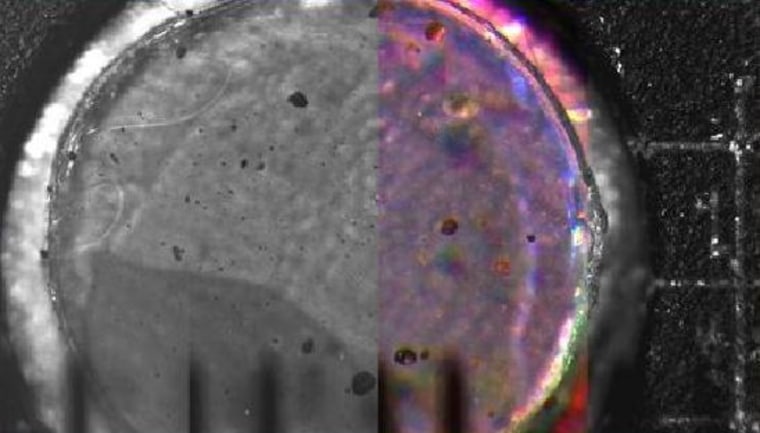The Phoenix lander has returned the highest-resolution pictures ever taken of dust and sand on the surface of another planet as it prepares for its primary mission of searching for signs of life on Mars, NASA scientists said on Thursday.
The pictures were taken through an optical microscope and showed particles — some as small as one-tenth the diameter of a human hair — that were collected on a slide when Phoenix touched down on May 25 at the arctic circle of the Red Planet, kicking up dust from the surface.
"We have images showing the diversity of mineralogy on Mars at a scale that is unprecedented in planetary exploration," Michael Hecht of the U.S. space agency's Jet Propulsion Laboratory said at a media briefing.
One of the tiny grains shown in the pictures, taken largely to test the lander's instruments, was clear and whitish but the scientists said it was a mineral — possibly salt -- and not likely ice, which they are eager to find as it is considered key to enabling life on the planet.
Other particles were reddish brown like the Mars surface or dark and glossy.
"What we're seeing in the microscope is almost certainly not ice," said Tom Pike, Phoenix geology team leader and a professor at Imperial College London, because a particle of ice that small would have melted before it could be photographed.
He said salt deposits, which are often found around ice, also would be intriguing to the Phoenix team.
Pike said the microscopic photos were never intended to seek out ice or other signs of water and life on Mars, and that the primary tool for that is a robotic arm.
The lander was again given commands to collect its first soil sample from the Martian surface after a communication glitch with an orbiting spacecraft delayed that experiment for a day.
Initial tests by the robotic arm scoop have uncovered a layer 1.5 inches deep near the landing site that intrigues NASA officials and they hope to study samples from that spot.
Phoenix's robotic camera has also sent back images of what appears to be exposed ice under the lander. But that area — dubbed "Snow Queen" — cannot be analyzed because it is out of the reach of the scoop.
The $420 million craft touched down on the arctic circle of Mars after a 10-month, 420 million-mile (680 million-kilometer) journey from Earth.
NASA has searched Mars for the past decade for signs of water and conditions that might have supported life. It has used a fleet of orbiters and a pair of rovers on the planet.
The detection of subsurface water on Mars in 2002 by the Odyssey spacecraft prompted the Phoenix mission.
